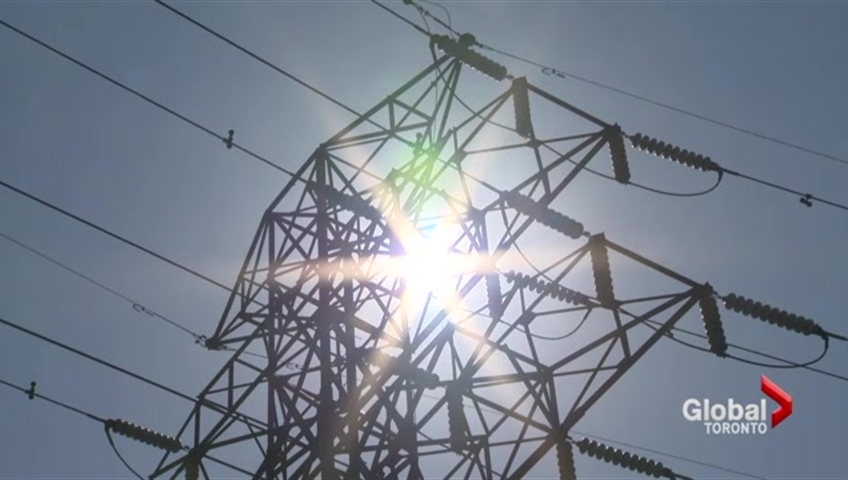Despite recent promises from the federal government of more than $185 billion in infrastructure spending over the next decade, Ontario electricity customers could soon be on the hook for up to $650 million toward the cost of connecting 16 remote First Nations communities to the province’s electricity grid.

READ MORE: Rural Ontarians left in the dark as electricity bills skyrocket
Designated a “priority transmission project” by the province in late July, meaning the needs assessment typically associated with such a proposal has been waived, the Wataynikaneyap Power transmission line will extend the province’s electricity grid roughly 1,800 kilometres into northwestern Ontario at a cost of about $1.9 billion.
“What’s important to convey to people that haven’t had the opportunity to visit these communities is that we are in a crisis situation,” said Margaret Kenequanash, chair of Watay Power and the executive director of Shibogama First Nations Council.
“Not only are the living conditions impacted by a lack of access to reliable power, but basic things that most people take for granted, like being able to open new businesses and build new homes can’t happen when a community is at capacity.”
Once complete, the project will provide clean, reliable electricity to approximately 10,000 residents of the 16 remote First Nations communities, reducing their dependence on diesel-generated electricity by up to 95 per cent.
“Connection to the grid will open the door for us to start building the infrastructure we so desperately need,” said Kenequanash. “It will also go a long way to helping us meet basic needs like food, shelter and water for our people.”
Proponents of the project say it will result in many environmental, social and economic benefits – not the least of which include reducing the likelihood of diesel spills, removing nearly six million tons of greenhouse gas emissions from the air, and saving beneficiaries of the project nearly $1 billion when compared to continued diesel use over the 40-year lifespan of the project.
However, Global News has learned that despite months of ongoing negotiation between the province and federal government – the two main parties responsible for paying for the transmission line – no cost-sharing agreement outlining exactly how much each party will pay has yet been agreed to.
READ MORE: Wynne’s promised tax break on hydro bills does little in the long run, say critics
“Reducing diesel dependency in First Nations communities is a priority for the Government of Canada,” said a statement released by the office of Carolyn Bennett, Canada’s minister of indigenous and northern affairs. “INAC, Natural Resources Canada and the Province of Ontario, through the Ministry of Energy, are working to develop a cost-share agreement that could support the Watay Power project.”
While Thibeault and Bennett have each declined to disclose exactly how much their respective ministries are willing to pay, they acknowledge the federal government’s unique responsibility with respect to First Nations communities.
“We do recognize that there’s federal jurisdiction and that’s part of the consultation that we’re doing right now,” said Thibeault. “Everyone is in agreement that this needs to get done, but we need to get it done correctly.”
According to Thibeault, “getting it done correctly” means both protecting the rights of Ontario’s remote First Nations communities, while remaining mindful of his responsibilities to Ontario ratepayers.
“It’s my job to make sure I always look out for the best interest of Ontario ratepayers,” said Thibeault. “But I also need to make sure I look out for the best interest of all Ontarians.”
Who currently pays for First Nations electricity?
In the early 1970s, Ontario launched an ambitious plan for the “electrification” of the entire province. As a result, Ontario Hydro – the government-owned precursor to Hydro One – signed a series of agreements with the federal government to share in the cost of producing diesel-generated electricity in the province’s northernmost First Nations communities.
“The agreements set out obligations and benefits for both INAC and Ontario Hydro,” said Tiziana Baccega Rosa, a spokesperson for Hydro One. “When the province broke up Ontario Hydro, these obligations were transferred to Hydro One Remote Communities.”
READ MORE: Ontario hydro costs: Timeline leading up to Wynne calling it an ’urgent issue’
Under the agreements – all of which are still in force today – the federal government agreed to cover upfront capital costs for setting up the diesel-powered systems. They also agreed to pay for any future costs associated with upgrading the systems.
Ontario Hydro, meanwhile, agreed to cover operational and management expenses, including the cost of purchasing and transporting diesel fuel to remote communities, as well as the cost of general maintenance and upkeep.
Ontario Hydro’s portion of these expenses were then added to the price of producing electricity in the province, which as a Crown corporation, the company could recover through either taxpayer-funded subsides or through the monthly bills of electricity users.
Today, the total cost of diesel-generated electricity in Ontario’s northernmost communities is roughly $100 million a year.
- S&P/TSX composite closes up nearly 100 points, U.S. stock markets mixed
- Pedestrian in life-threatening condition after being hit by vehicle in Mississauga
- Judge at trial of man accused of killing cop was concerned over Crown changing theory
- Ontario transportation minister pitches 24-hour work to speed up Gardiner construction
The federal government, through Indigenous and Northern Affairs Canada, pays 56 per cent of this cost, or roughly $55 million a year, while Ontario electricity customers, through the ratepayer-funded subsidy known as the Rural or Remote Rate Protection plan, pay roughly 35 per cent of the total, or just under $33 million a year.
The remaining 10 per cent or so – roughly $9 million dollars each year – is paid for by members of the First Nations communities themselves through their monthly utility bills.
Finally, the government of Ontario purchases about $1 million a year worth of electricity at above-market prices to run government buildings in the remote northern communities.
Who should pay for transmission projects?
According to the most recent draft version of a report prepared by the Independent Electricity System Operator (IESO), the organization tasked with administering Ontario’s electricity system, transmission line projects to connect remote communities in the province’s northwest should primarily be paid for by those who stand to benefit most from the projects, which in the case of the Watay transmission line project, the IESO argues, is the federal government and Ontario ratepayers.
READ MORE: New data highlights hydro affordability crisis for rural Ontario
“The financial benefits of connecting remote communities will accrue to the parties that currently fund their electricity systems, most notably the Government of Canada and Ontario electricity customers,” states the 2014 report. “Discussions toward a funding agreement may find a starting point in the notion that connection costs should be attributed to the parties that benefit.”
It’s a sentiment echoed by Thibeault.
“There are going to be significant savings for Ontario ratepayers,” said Thibeault. “We’re spending $90 million a year on diesel right now and we’re looking at saving – once we get this in place – $700 million.”
If in the end costs are divided along these lines, Ontario ratepayers, who currently cover about 35 per cent of diesel-generation costs, could be responsible for as much as $650 million of the $1.9 billion project.
According to Thibeault, these amounts would be recovered over a 20-25-year payback period and would be funded through Rural or Remote Rate Protection (RRRP), which interestingly enough, was amended earlier this year to allow for funds previously earmarked for rate subsidies to be used for the construction of transmission line projects to connect remote First Nations communities.
READ MORE: Ontario Liberals promise to remove provincial portion of HST from hydro bills
Meanwhile, the federal government, whose promises on infrastructure spending and commitments to First Nations communities make this issue seem, at least at first glance, like a Cinderella-type story – where the glass slipper just fits – would be responsible for roughly $1.1 billion of the total cost.
The remaining $200 million or so would be recovered from the First Nations communities through their electricity bills.
Taxpayer vs ratepayer
The strategy of funding transmission line projects through ratepayer-supported initiatives doesn’t sit well with everyone – particularly if such projects are more in line with social policy than good economic theory.
“I would hope that any project that is unable to sustain itself financially through user fees should be paid for through the general revenue fund and not hydro bills,” said Brady Yauch, executive director and economist at the Toronto-based Consumer Policy Institute.
While Yauch says he’s not familiar enough with the Watay Project to comment on it specifically, his remarks reflect a belief that ratepayer-funded subsidies unfairly penalize those who can least afford to pay more on their monthly electricity bills.
According to Yauch, funding necessary but economically unviable projects through general tax revenue makes sense because it alleviates the burden on low-income families who pay electricity bills, but might not pay as much in taxes.
Under such a policy, the cost of constructing transmission lines like the Watay Power project, which will require subsides throughout its entire 40-year life, would fall upon taxpayers – meaning those who can afford to pay more through higher taxes would contribute significantly toward the total cost of the project, while those who can’t afford to pay higher taxes won’t be unnecessarily burdened.
For now, it seems both governments are intent on pushing full-steam ahead with the project despite the absence of any cost-sharing agreement – meaning exactly how much of the bill Ontario ratepayers will be left to foot remains unknown.











Comments